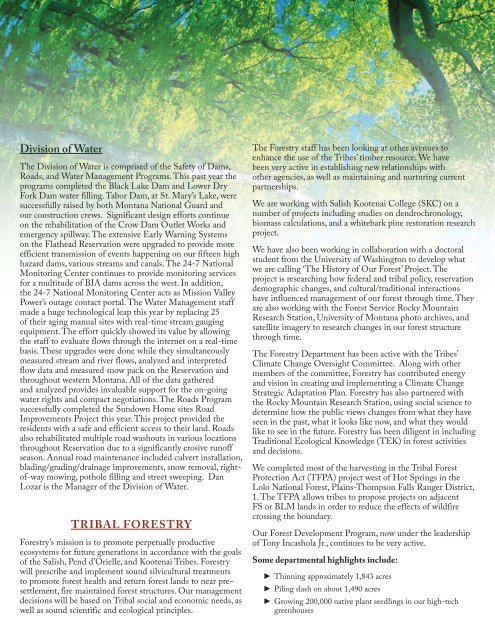2014-15 Annual Report
Create successful ePaper yourself
Turn your PDF publications into a flip-book with our unique Google optimized e-Paper software.
Division of Water<br />
The Division of Water is comprised of the Safety of Dams,<br />
Roads, and Water Management Programs. This past year the<br />
programs completed the Black Lake Dam and Lower Dry<br />
Fork Dam water filling. Tabor Dam, at St. Mary’s Lake, were<br />
successfully raised by both Montana National Guard and<br />
our construction crews. Significant design efforts continue<br />
on the rehabilitation of the Crow Dam Outlet Works and<br />
emergency spillway. The extensive Early Warning Systems<br />
on the Flathead Reservation were upgraded to provide more<br />
efficient transmission of events happening on our fifteen high<br />
hazard dams, various streams and canals. The 24-7 National<br />
Monitoring Center continues to provide monitoring services<br />
for a multitude of BIA dams across the west. In addition,<br />
the 24-7 National Monitoring Center acts as Mission Valley<br />
Power’s outage contact portal. The Water Management staff<br />
made a huge technological leap this year by replacing 25<br />
of their aging manual sites with real-time stream gauging<br />
equipment. The effort quickly showed its value by allowing<br />
the staff to evaluate flows through the internet on a real-time<br />
basis. These upgrades were done while they simultaneously<br />
measured stream and river flows, analyzed and interpreted<br />
flow data and measured snow pack on the Reservation and<br />
throughout western Montana. All of the data gathered<br />
and analyzed provides invaluable support for the on-going<br />
water rights and compact negotiations. The Roads Program<br />
successfully completed the Sundown Home sites Road<br />
Improvements Project this year. This project provided the<br />
residents with a safe and efficient access to their land. Roads<br />
also rehabilitated multiple road washouts in various locations<br />
throughout Reservation due to a significantly erosive runoff<br />
season. <strong>Annual</strong> road maintenance included culvert installation,<br />
blading/grading/drainage improvements, snow removal, rightof-way<br />
mowing, pothole filling and street sweeping. Dan<br />
Lozar is the Manager of the Division of Water.<br />
TRIBAL FORESTRY<br />
Forestry’s mission is to promote perpetually productive<br />
ecosystems for future generations in accordance with the goals<br />
of the Salish, Pend d’Orielle, and Kootenai Tribes. Forestry<br />
will prescribe and implement sound silvicultural treatments<br />
to promote forest health and return forest lands to near presettlement,<br />
fire maintained forest structures. Our management<br />
decisions will be based on Tribal social and economic needs, as<br />
Photo well as Provided sound scientific by Whisper and Camel ecological - NRD principles. FWRC<br />
The Forestry staff has been looking at other avenues to<br />
enhance the use of the Tribes’ timber resource. We have<br />
been very active in establishing new relationships with<br />
other agencies, as well as maintaining and nurturing current<br />
partnerships.<br />
We are working with Salish Kootenai College (SKC) on a<br />
number of projects including studies on dendrochronology,<br />
biomass calculations, and a whitebark pine restoration research<br />
project.<br />
We have also been working in collaboration with a doctoral<br />
student from the University of Washington to develop what<br />
we are calling ‘The History of Our Forest’ Project. The<br />
project is researching how federal and tribal policy, reservation<br />
demographic changes, and cultural/traditional interactions<br />
have influenced management of our forest through time. They<br />
are also working with the Forest Service Rocky Mountain<br />
Research Station, University of Montana photo archives, and<br />
satellite imagery to research changes in our forest structure<br />
through time.<br />
The Forestry Department has been active with the Tribes’<br />
Climate Change Oversight Committee. Along with other<br />
members of the committee, Forestry has contributed energy<br />
and vision in creating and implementing a Climate Change<br />
Strategic Adaptation Plan. Forestry has also partnered with<br />
the Rocky Mountain Research Station, using social science to<br />
determine how the public views changes from what they have<br />
seen in the past, what it looks like now, and what they would<br />
like to see in the future. Forestry has been diligent in including<br />
Traditional Ecological Knowledge (TEK) in forest activities<br />
and decisions.<br />
We completed most of the harvesting in the Tribal Forest<br />
Protection Act (TFPA) project west of Hot Springs in the<br />
Lolo National Forest, Plains-Thompson Falls Ranger District,<br />
1. The TFPA allows tribes to propose projects on adjacent<br />
FS or BLM lands in order to reduce the effects of wildfire<br />
crossing the boundary.<br />
Our Forest Development Program, now under the leadership<br />
of Tony Incashola Jr., continues to be very active.<br />
Some departmental highlights include:<br />
► Thinning approximately 1,843 acres<br />
► Piling slash on about 1,490 acres<br />
► Growing 200,000 native plant seedlings in our high-tech<br />
greenhouses



